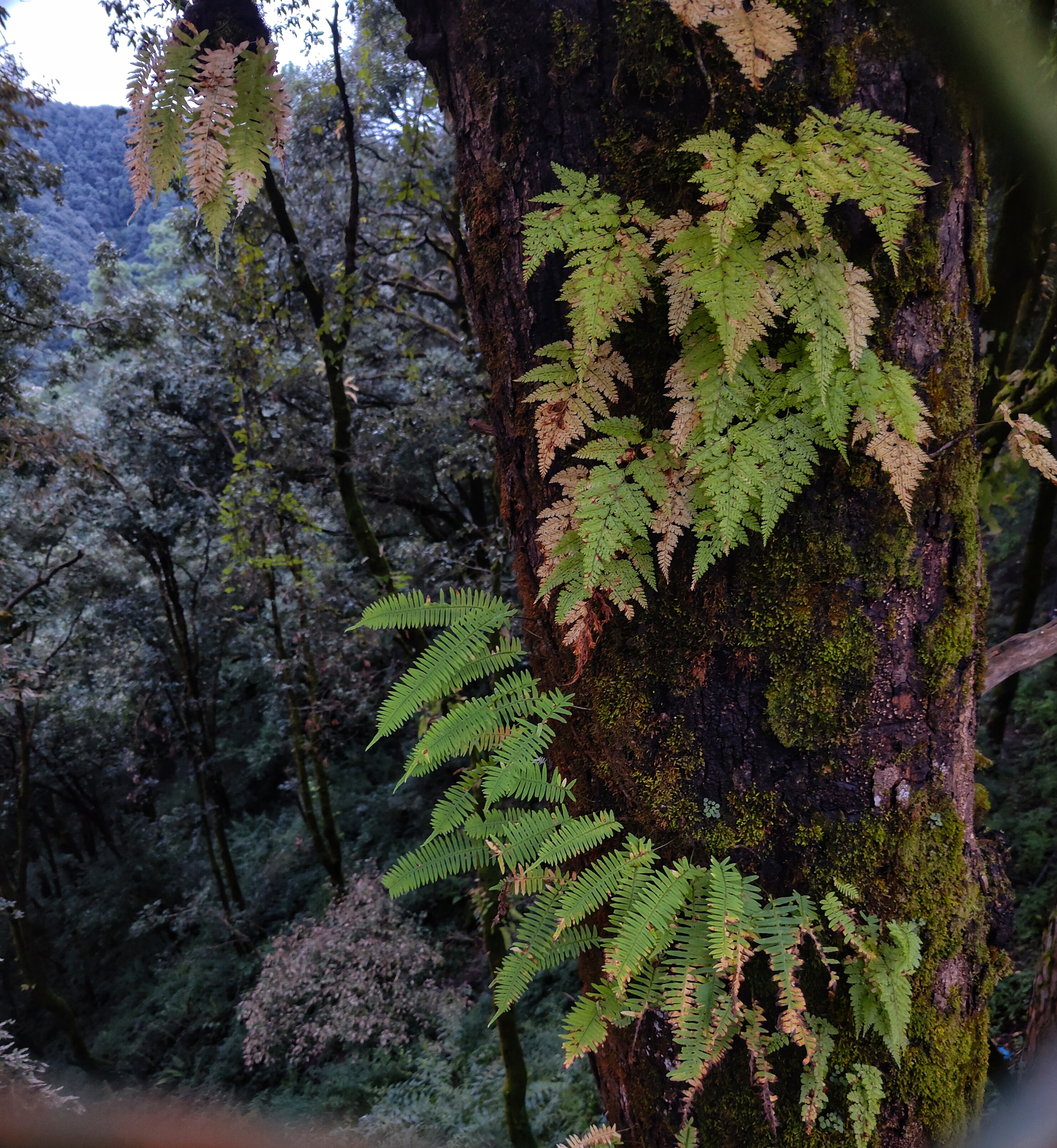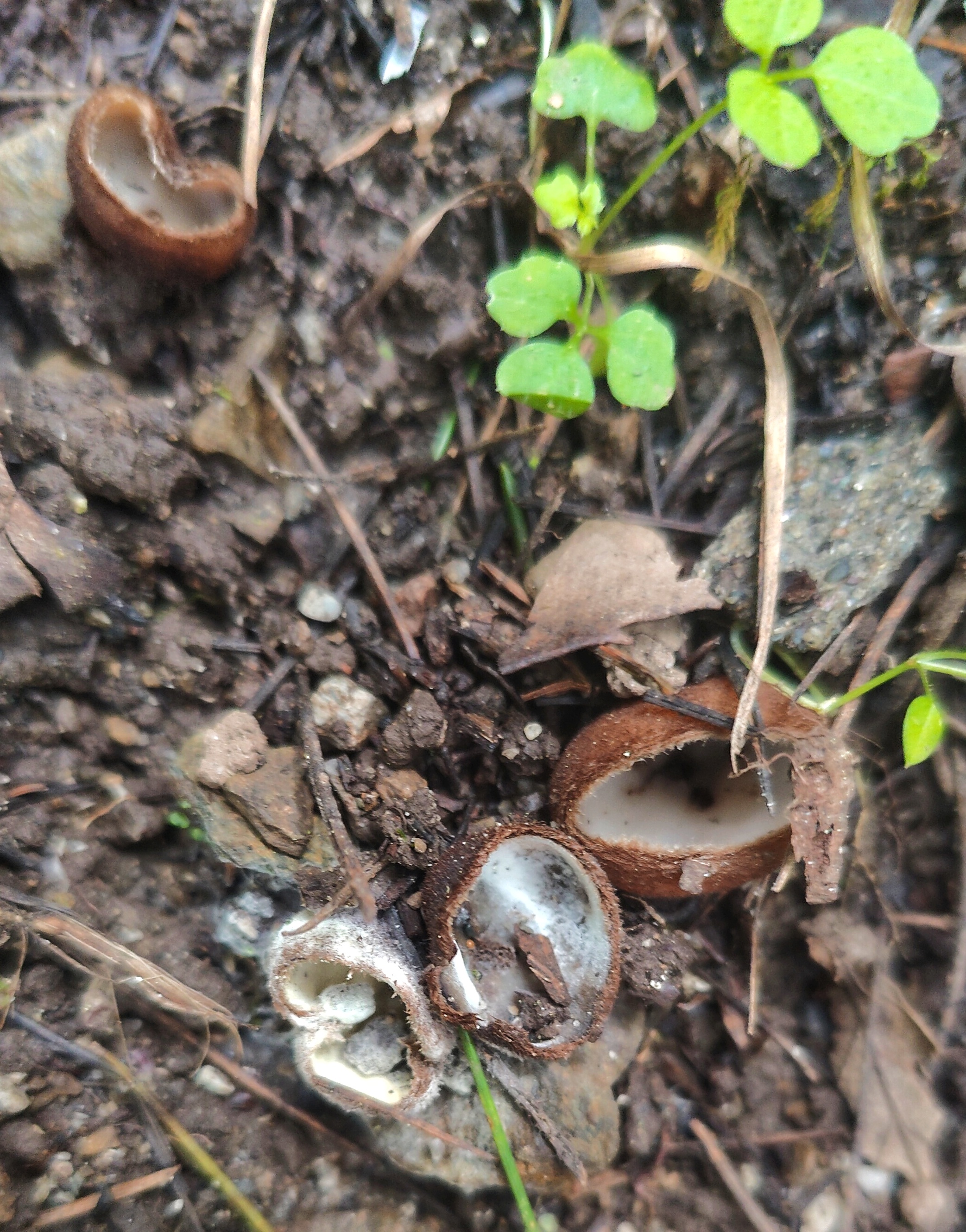While hiking in the woods today, I came across this big Oak tree. It was fascinating to observe two different species of ferns growing over moss covered bark. They were growing on the same aspect of the tree bole. The ferns were growing alongside each other but they respected each other’s boundaries. This is the season when ferns start turning brown. Yes of course, the winter season has arrived on the hillside of Landour, Mussoorie. The last stretch of ferns growing in the hillside for the year. They will again visit us in the coming year during the summer season. The Oak trees shelter multitude biodiversity of different lifeforms. Different species of mosses, ferns, fungi, mycorrhizas, insects, birds, animals take shelter in the nook and corner of this life supporting tree. The fern on the top is the Asplenium sp. whereas the lower one is the Polypodies sp. There is so much to learn from nature. Sometimes I think If only we could learn from nature how to coexist while respecting each other’s differences, this world will be a better place to live. Please refer to the following articles if you want to know more about Oak trees growing in the hillside of Landour, Mussoorie. https://chandrimadebi.com2022/09/17/wild-mushrooms-of-landour-mussoorie/ https://chandrimadebi.com2022/05/15/forestry-for-kids-saving-deodar-and-oak-forest-from-invasive-vines/ https://chandrimadebi.com2021/05/22/biodiversity-around-me-landour-mussoorie/ https://chandrimadebi.com2021/07/23/avian-visitors-of-oak-tree-quercus-leucotrichophora-pollination-ecology/ Thank you Like, share and follow. ? https://www.facebook.com/Dr.ChandrimaDebi/ https://www.instagram.com/debichandrima/ https://www.sumanmitra.com/ ©All images and content are subjected to copyright © 2022 chandrimadebi https://chandrimadebi.com
Forestry for Kids: Learning Soil thermodynamics in outdoor education
Thermodynamics is a topic of study in sciences which lays its foundation in the middle year education program in most of the national or international curriculums. Thermodynamics is the scientific study of the relations between heat and other forms of energy. In simple words, thermodynamics is the dynamics of the heat energy. Educators and students use ample platforms and resources to understand the topic, which also involves learning fun through fun videos and experiments. But it is an extensive topic and often the learning seems monotonous alongside classroom demonstrations. In this context, integrating the topic of thermodynamics along with outdoor education has far reaching implications. Practical and hands-on observation of thermodynamics i.e. heat transfer and heat exchange offers an experience in its own. In an attempt to integrate outdoor education with the learning of thermodynamics, the students participated in an experiment where they recorded soil temperature under different soil ecology. The study was conducted in the month of May in the hillside of Landour, Mussoorie. The students recorded soil temperature with the help of laboratory soil thermometers to find soil temperature variation at 5cm, 10 cm and 20 cm depth during nature walks. Following is the bar graph of temperature variation under different soil ecology in the hillside of Landour, Mussoorie. There is ample scope of study of forest soil and preliminary soil temperature study is only one aspect. In an attempt to understand the topic of thermodynamics the students of middle years ventured outdoors to record soil temperatures. The soil temperature is a crucial factor to estimate soil microbial activity, plant as well as soil health also interrelation with various aspects of ecology and environment. I am not sure whether this study has been done before at middle year education program integration with outdoor education or not. Even though the students variations in soil temperature, the analysis of the data is far away from the clear picture because these experiments need recording data throughout the year. So, the present activity is a simple demonstration with which the science unit of Fire and Ice can be correlated with soil thermodynamics. There are numerous other experiments which can be done to correlate Science units with Outdoor Education. We are all aware of the importance of nature based education in the overall well being of the child and in this regard integration of outdoor education with the basic curriculum has far reaching implications. If you want to know about the methodology, field tables or any other topics based on the topic, please feel free to contact me. Thank you Like, share and follow. ? https://www.facebook.com/Dr.ChandrimaDebi/ https://www.instagram.com/debichandrima/ https://www.sumanmitra.com/ ©All images and content are subjected to copyright © 2022 chandrimadebi https://chandrimadebi.com
Fairy Cup Mushrooms in the hillside of Landour, Mussoorie : Forestry for kids
After consecutive days of heavy rainfall, the bright sunny days in the hillside of Landour have finally arrived. This year extended rainy days were experienced otherwise October is usually the most adored months in the hillside. So, we decided to go for a brisk nature walk in the vicinity along with the children. Children were so engrossed with nature under warm sun. While some were busy exploring the monsoon blossoms, few were busy exploring insect hideouts and nests. It gives immense satisfaction to see little children exploring the nature with curiousity and eagerness. The nature never fails to surprise me and as always I was occupied in exploring the rich biodiversity. Somewhere, I feel children are naturally gifted with instincts and if properly guided they are better nature explorers than adults. I feel nature also selects only a few of us to decipher her secrets. It happened so, that one of the children was eager to show me one specimen which she identified as a mushroom. Initially, I was unsure and thought that they must be some decayed acorns lying on the forest floor. But she persisted to have a close look into them. She called her mushrooms as ‘Coconut mushrooms’ due to coconut like fibre shell of the mushroom. Although I had severe backache, I somehow managed to get on the hill slopes where she found the mushrooms. It was lying beneath the Deodar tree among the roots. I was astonished to find Brown haired fairy Cup Mushrooms for the first time on the hillside of Landour, Mussoorie. Although the mushroom was previously reported in the 1950’s from Mussoorie, this was my first experience to see Fairy Cup Mushrooms in their natural habitat. Fairy Cup Mushrooms are ectomycorrhizal and are very important for the health and vigour of the trees. Ectomycorrhizal fungi (EMF) are symbionts with most temperate and boreal forest trees, providing their hosts with soil nutrients and water in exchange for plant carbon. This group of fungi is involved in woody plants’ survival and growth and helps plants tolerate harsh environmental conditions. Humaria hemisphaericaDescriptionThey are goblet shaped when young, and gradually become cup-shaped and reaching widths of 2-3 cm when mature, fairly smooth; under surface densely hairy with prominent hairs that extend above the margin of the cup, brown; odour none; flesh brownish or pale, brittle. This species typically does not have a stipe although there is small abrupt base sometimes. This mycorrhizal fungus is recognized by its white inner surface and hairy brown outer surface.Ecology: Humaria hemisphaerica grows solitary, scattered, or in groups on the ground or sometimes on rotten wood in wooded areas. It was found growing in clusters in the rhizosphere of Deodar tree (Figure A).Specimen examined – The sample was collected from Woodstock School, Landour, Mussoorie, Uttarakhand, India, 27 September 2022, WS/HH 06Microscopic features: Spores 20-24 x 10-12 µ; elliptical, often with somewhat flattened ends; Asci eight-spored (Kuo, 2012)Discussion: It is commonly known as the hairy fairy cup (Arora, 1986) is a species of fungi in the family Pyronemataceae. This mycorrhizal fungus is recognized by its white inner surface and hairy brown outer surface. Previously it was reported by Thind and Sethi (1957) on dead twigs and soil under Cedrus forest in Mussoorie.Edibility: Inedible Though a lot is known about how mushrooms can benefit humans, little attention is given to the importance of mushrooms to the forest. Although there are reports of various mushrooms from Mussoorie, meagre information is available on the diversity of mushrooms in the hillside of Landour, Mussoorie. Wild mushroom are involved in the formation of ectomycorrhizal associations with the rootlets of the trees, with both partners in the relationship helping each other in many different ways Thank you Like, share and follow. ? https://www.facebook.com/Dr.ChandrimaDebi/ https://www.instagram.com/debichandrima/ https://www.sumanmitra.com/ ©All images and content are subjected to copyright © 2022 chandrimadebi https://chandrimadebi.com




